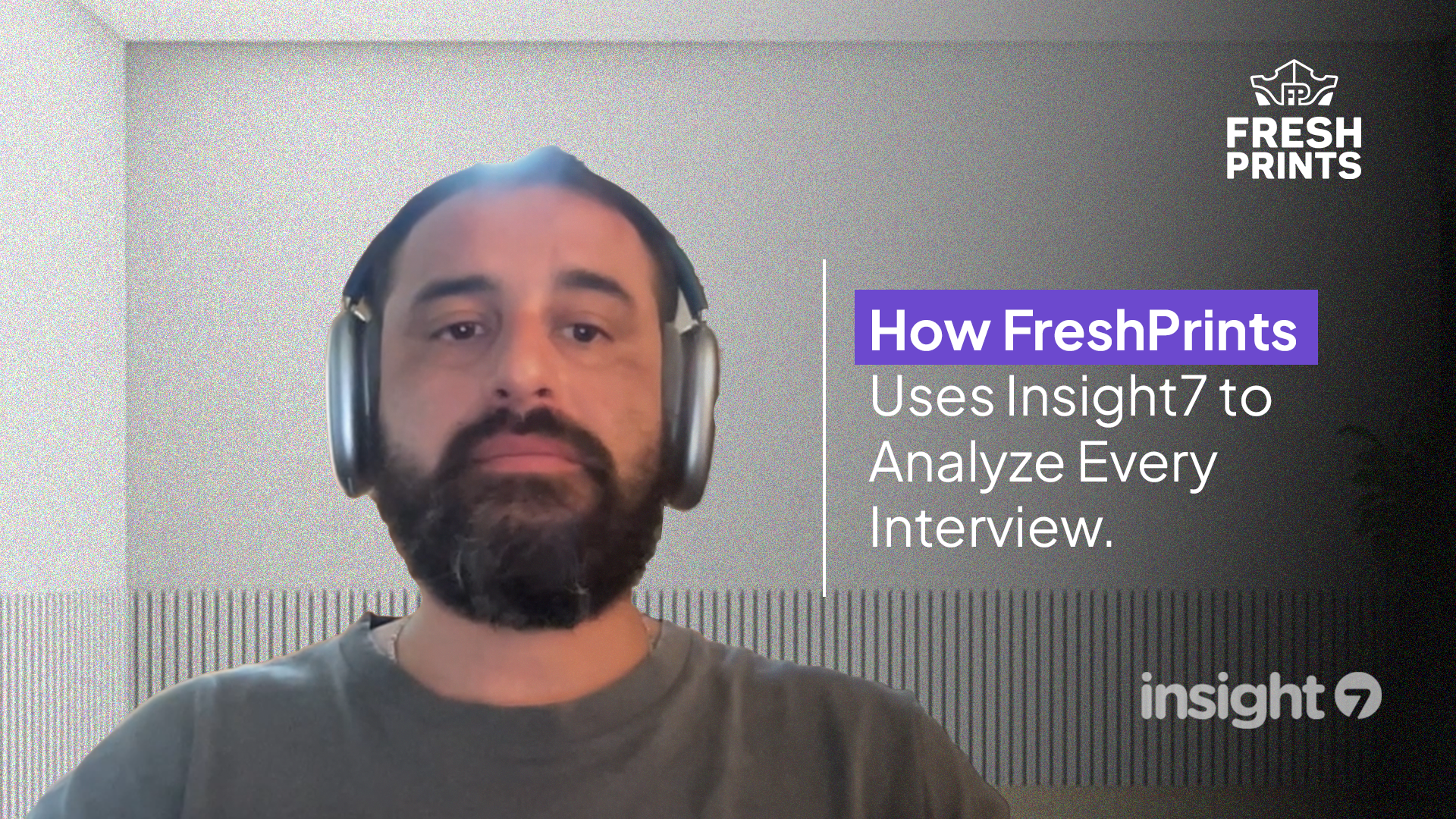Top AI Qualitative Research Analysis Tools For Market Research
-
Bella Williams
- 10 min read
In the ever-evolving landscape of market research, the use of AI Market Analysis Tools has emerged as a game-changer. These tools transform vast data into actionable insights, allowing researchers to make informed decisions swiftly. As companies face increasing pressure to understand consumer behavior, AI-driven solutions provide a competitive edge by identifying trends and sentiments that may otherwise go unnoticed.
The integration of AI tools in qualitative research streamlines the analysis process, making it faster and more efficient. Researchers can delve deeper into customer feedback, extracting valuable insights from complex datasets. This not only enhances the overall quality of market analysis but also empowers organizations to adapt swiftly in a dynamic market environment.
Analyze & Evaluate Calls. At Scale.

Understanding AI Market Analysis Tools in Qualitative Research
AI Market Analysis Tools have become essential in qualitative research, transforming how researchers extract insights from complex data. These tools streamline data analysis by employing advanced algorithms to sift through vast datasets, making it easier to identify trends and sentiments. With the ability to analyze customer feedback and opinions, researchers can gain a deeper understanding of market needs, preferences, and pain points.
Understanding these tools involves recognizing their functionalities. Key capabilities include natural language processing, which enables the analysis of unstructured text data from surveys, reviews, or social media. Additionally, visualization features allow users to see patterns and correlations more clearly, facilitating informed decision-making. This integration of AI not only enhances accuracy but also significantly reduces the time needed for analysis. By utilizing AI market analysis tools, researchers can focus on strategic insights that shape product development and marketing strategies, leading to more tailored consumer offerings.
The Role of AI in Modern Market Analysis
AI Market Analysis Tools have transformed how businesses understand consumer behavior and market trends. In modern market analysis, artificial intelligence enables companies to process vast amounts of data quickly and accurately. This rapid analysis helps identify patterns and insights that would otherwise be missed, allowing businesses to make informed decisions.
One of the primary roles of AI in market analysis is to enhance qualitative research methods. AI tools can analyze customer feedback, interviews, and online interactions, generating actionable insights efficiently. By synthesizing data from various sources, these tools empower market researchers to uncover nuances in customer sentiments, preferences, and motivations. This capability not only improves the quality of insights but also speeds up the decision-making process, enabling organizations to respond to market shifts more effectively. Embracing AI in modern market analysis is essential for staying ahead in today's competitive landscape.
Benefits of Using AI Tools in Qualitative Research
AI Market Analysis Tools bring transformative benefits to qualitative research, enhancing the overall research process significantly. One notable advantage is the speed at which these tools analyze vast amounts of qualitative data. Traditional methods of analysis can be time-consuming and prone to human error. In contrast, AI-powered tools can sift through transcripts, interviews, and focus group discussions in seconds, summarizing key findings effortlessly.
Moreover, these tools enable researchers to identify patterns and trends that might stay hidden through manual analysis. By using AI for qualitative insights, organizations can make data-driven decisions faster and more accurately. Another key benefit is the ability to visualize data in meaningful ways, unlocking insights that can lead to actionable strategies. Overall, incorporating AI Market Analysis Tools into qualitative research not only streamlines efforts but also enhances the depth and reliability of insights gained.
Top AI Qualitative Research Analysis Tools for Market Research
Effective AI Market Analysis Tools have transformed qualitative research, providing researchers with innovative ways to analyze data. The emergence of these tools has changed how businesses interpret consumer feedback, opening avenues to extract actionable insights. Utilizing AI in market research can streamline your data analysis process and uncover patterns that might be missed through manual methods.
Several tools excel in this space. For instance, one tool allows users to upload and transcribe audio files efficiently, filtering out key quotes and sentiments from customer interactions. Another tool offers comprehensive data analysis through a matrix setup, making it easy to draw comparisons across different datasets. These robust AI Market Analysis Tools are designed to enhance decision-making by providing clearer visibility into consumer attitudes and trends, ultimately driving business growth.
Extract insights from interviews, calls, surveys and reviews for insights in minutes
Insight7: Leading the Way in AI Market Analysis Tools
AI Market Analysis Tools are at the forefront of market research innovation, transforming how businesses derive insights from customer interactions. As organizations collect vast amounts of data, the need for effective tools to analyze this information has never been more critical. Traditional methods often fall short in handling the scale and complexity of feedback generated today, leading to slower decision-making processes. This is where advanced AI tools come into play, enabling businesses to analyze customer conversations efficiently and effectively.
By integrating AI-driven solutions, companies can streamline their analysis, translating insights into actionable strategies more rapidly. Moreover, these tools facilitate collaboration, ensuring that valuable insights are easily accessible and can be shared across teams. Emphasizing real-time data analysis empowers businesses to stay ahead of competitors, making informed decisions based on current customer signals. Embracing these AI Market Analysis Tools means unlocking the potential to enhance understanding of customer needs, ultimately leading to improved business outcomes.
Additional Tools Enhancing Market Research
To enhance market research, a variety of additional tools can significantly improve data analysis and insight generation. These tools complement the core AI market analysis tools by offering specialized features that deepen the understanding of consumer behavior and market trends. For instance, sentiment analysis platforms can scrutinize customer feedback and detect emotional tones, providing a richer context to qualitative data.
Furthermore, video insights tools allow researchers to analyze recorded interviews, extracting non-verbal cues and behavioral nuances. Ideally, when integrated with AI market analysis tools, these additional resources create a more comprehensive understanding of market dynamics. By combining traditional analysis methodologies with advanced technologies, businesses can uncover deeper insights and respond more agilely to changes in consumer preferences. In this evolving landscape, leveraging such tools becomes essential for achieving a competitive edge in market research.
Tool #1: Discuss capabilities and unique features
The first tool in our exploration of AI market analysis tools showcases remarkable capabilities and unique features tailored for effective qualitative research. This platform excels in data ingestion from various sources, transforming raw information into actionable insights. Users appreciate how it can transcribe and analyze numerous calls, providing detailed reports that highlight trends and customer sentiments.
Additionally, this tool offers a versatile dashboard that users can customize based on their specific needs. It allows them to compare data sets from diverse geographies, enabling a deeper understanding of market dynamics. With real-time querying capabilities, users can ask pertinent questions and receive instant feedback, making it an invaluable resource for market research. The emphasis on data security ensures that client information remains confidential, thus creating a trustworthy environment for qualitative analysis. These features position this tool at the forefront of AI-driven market research advancements.
Tool #2: Discuss capabilities and unique features
When examining AI Market Analysis Tools, one must appreciate their distinctive capabilities and features that set them apart in qualitative research. These tools effectively ingest and process large volumes of data from various sources, providing invaluable insights for market analysis. A standout feature includes real-time data transcription and analysis, allowing teams to quickly assess customer interactions and trends. By clustering data based on attributes such as geographical location, users can compare insights across different groups or projects effortlessly.
Another unique capability is the interactive query function, enabling users to ask specific questions regarding consumer sentiments or opinions. This functionality fosters a more engaging analysis experience, transforming raw data into comprehensible reports. Additionally, stringent data privacy protocols are essential, ensuring compliance with regulations. Ultimately, the advanced analytics interfaces and customizable dashboards offered by these AI tools empower organizations to adapt to market demands while enhancing their research strategies effectively.
Tool #3: Discuss capabilities and unique features
AI Market Analysis Tools enable researchers to extract meaningful insights from qualitative data efficiently. One of the most impressive capabilities of these tools is their ability to transcribe and analyze a variety of communication sources, such as phone calls and interviews. Users can categorize these conversations into projects, allowing for comparative analysis based on location or other attributes, which enhances the depth of market understanding.
Additionally, these tools provide interactive dashboards where users can query the data in real-time. This feature empowers researchers to gain instant feedback on customer sentiments regarding specific topics. Moreover, compliance with data security regulations ensures that user interactions are safe and confidential. Unique features, such as customizable reporting and the ability to generate marketing assets directly from insights, make these AI tools indispensable for organizations aiming to stay ahead in market trends.
Tool #4: Discuss capabilities and unique features
When evaluating AI Market Analysis Tools, it’s essential to discuss their capabilities and unique features that set them apart. First, these tools often incorporate advanced data processing techniques, allowing for the rapid transcription and analysis of various sources. This accelerates the research process and provides invaluable insights from conversations and surveys.
Second, users can expect customizable dashboards, which offer real-time monitoring of relevant metrics. This flexibility enables teams to adapt their approach based on evolving market demands, ultimately leading to better strategic decisions. Additionally, many of these platforms facilitate collaborative features, allowing team members to share findings seamlessly and engage in meaningful discussions. Such functionalities not only streamline workflow but also significantly enhance the overall quality of qualitative research. By leveraging these capabilities, organizations can transform data into actionable insights, driving successful marketing strategies.
Conclusion: The Future of AI Market Analysis Tools in Market Research
As we look toward the future, AI Market Analysis Tools will continue to evolve, transforming market research methodologies. These tools are increasingly sophisticated, enabling researchers to extract meaningful insights quickly and effectively from vast datasets. With advancements in natural language processing and machine learning, AI is set to redefine how qualitative research is conducted, making data analysis more intuitive and accessible.
Moreover, we can anticipate greater integration of AI Market Analysis Tools across various sectors, enhancing collaboration among teams. Organizations will rely on these tools not only for data analysis but also for generating actionable strategies based on real-time insights. As AI continues to advance, the potential for richer, more nuanced understanding of consumer behavior will undoubtedly shape the future of market research.







